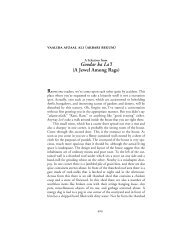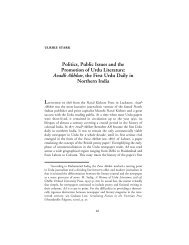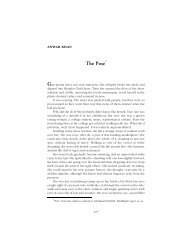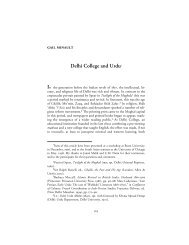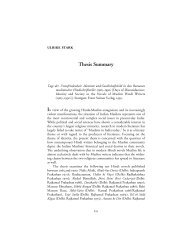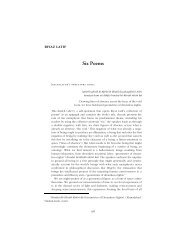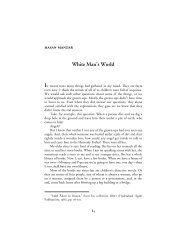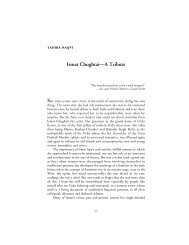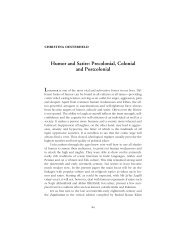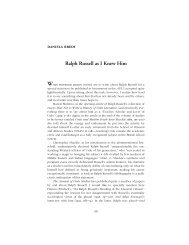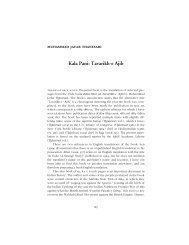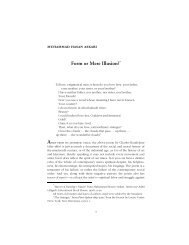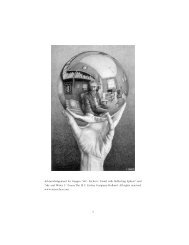Echoes and Exuberances: Baidar Bakht's Recent Translations of ...
Echoes and Exuberances: Baidar Bakht's Recent Translations of ...
Echoes and Exuberances: Baidar Bakht's Recent Translations of ...
Create successful ePaper yourself
Turn your PDF publications into a flip-book with our unique Google optimized e-Paper software.
CARLO COPPOLA • 155This theme is similarly developed in “In a Split Second” (p. 47). Awoman (the speaker) <strong>and</strong> a man meet in an elevator. She fails to avert hereyes, as a “proper” South Asian woman would, but makes eye contact:“We looked at each other,” she admits, then adds, “that’s all,” as if todeny the implied cultural sexual overtones in her action. He exits beforeshe does, but she daydreams (the daylight counterpart to erotic nighttimedreams portrayed in “Fear <strong>of</strong> Dream in a Dream” above) on what mighthave happened if she had “followed him.” She states, “I’d be a corpse inhis way.” As if she is reading his thoughts, distancing such thinking fromher own psyche <strong>and</strong> projecting it onto his, she continues, usingtraditional poetry to describe the night <strong>of</strong> union <strong>of</strong> lovers:I remember well his thoughts;They were feelings like wine.All night, that pleasure intoxicated me;But by the morningMy body filled with roomIn the shape <strong>of</strong> empty bottlesAnd ravaged cigarette butts.The images in this poem, as can be readily seen, are not onlytraditional but also subtly sexual.Autumn also seems to be a critical image in the poet’s middle poetry,but especially in the later volumes—Mal≥matå k® Darmiy≥ (AmidstReproaches; 1981) <strong>and</strong> Siy≥h ƒ≥iy® m® Gul≥bµ Rag (Pink Color in theBlack Margin; 1986)—it becomes a basic, sustaining matrix <strong>of</strong> her verse.In the early poetry, spring <strong>and</strong> the color green, especially grass (most fullydeveloped in the poem “The Grass Is Like Me,” p. 34), are images <strong>of</strong>renewal <strong>and</strong> hope, <strong>of</strong>ten equated with the power <strong>of</strong> women to regenerate,both physically <strong>and</strong> morally, the human race. In the later poetry greengives way to earthen tones, dust, <strong>and</strong> autumn with its seared leaves, all <strong>of</strong>which become a dominant cluster <strong>of</strong> images. Autumn, <strong>of</strong>ten in concertwith the image <strong>of</strong> cobwebs, <strong>of</strong>ten depicts a sense <strong>of</strong> entrapment, not onlyin relationships, social mores, a country with a dubious political situation,but in one’s human body as well, especially as one ages. In “AutumnSong” the speaker describes her h<strong>and</strong>s as “dust-ravaged like dry bread” (p.13). “The Second Birth” (p. 88) is a compelling poem about wives whohave “learnt to live / As the doorway dust” while their husb<strong>and</strong>s aretreated to the “second birth” <strong>of</strong> the title, i.e., visiting prostitutes. In “Savethe Sun from the Rain” (pp. 136–137) “Dry leaves” are a reminder <strong>of</strong>



